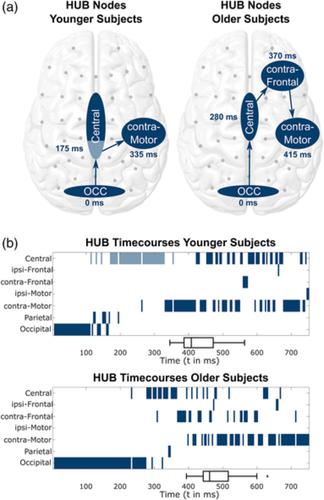当前位置:
X-MOL 学术
›
Hum. Brain Mapp.
›
论文详情
Our official English website, www.x-mol.net, welcomes your
feedback! (Note: you will need to create a separate account there.)
Stimulus transformation into motor action: Dynamic graph analysis reveals a posterior‐to‐anterior shift in brain network communication of older subjects
Human Brain Mapping ( IF 3.5 ) Pub Date : 2020-12-11 , DOI: 10.1002/hbm.25313 Nils Rosjat 1, 2 , Bin A Wang 1, 3 , Liqing Liu 1, 2, 4 , Gereon R Fink 1, 5 , Silvia Daun 1, 5
Human Brain Mapping ( IF 3.5 ) Pub Date : 2020-12-11 , DOI: 10.1002/hbm.25313 Nils Rosjat 1, 2 , Bin A Wang 1, 3 , Liqing Liu 1, 2, 4 , Gereon R Fink 1, 5 , Silvia Daun 1, 5
Affiliation

|
Cognitive performance slows down with increasing age. This includes cognitive processes that are essential for the performance of a motor act, such as the slowing down in response to an external stimulus. The objective of this study was to identify aging‐associated functional changes in the brain networks that are involved in the transformation of external stimuli into motor action. To investigate this topic, we employed dynamic graphs based on phase‐locking of Electroencephalography signals recorded from healthy younger and older subjects while performing a simple visually‐cued finger‐tapping task. The network analysis yielded specific age‐related network structures varying in time in the low frequencies (2–7 Hz), which are closely connected to stimulus processing, movement initiation and execution in both age groups. The networks in older subjects, however, contained several additional, particularly interhemispheric, connections and showed an overall increased coupling density. Cluster analyses revealed reduced variability of the subnetworks in older subjects, particularly during movement preparation. In younger subjects, occipital, parietal, sensorimotor and central regions were—temporally arranged in this order—heavily involved in hub nodes. Whereas in older subjects, a hub in frontal regions preceded the noticeably delayed occurrence of sensorimotor hubs, indicating different neural information processing in older subjects. All observed changes in brain network organization, which are based on neural synchronization in the low frequencies, provide a possible neural mechanism underlying previous fMRI data, which report an overactivation, especially in the prefrontal and pre‐motor areas, associated with a loss of hemispheric lateralization in older subjects.
中文翻译:

刺激转化为运动动作:动态图分析揭示了老年受试者大脑网络通信的从后到前的转变
认知能力随着年龄的增长而减慢。这包括对于执行运动行为至关重要的认知过程,例如对外部刺激的反应减慢。本研究的目的是确定大脑网络中与衰老相关的功能变化,这些变化涉及外部刺激转化为运动动作。为了研究这个主题,我们采用了基于健康年轻和年长受试者记录的脑电图信号锁相的动态图,同时执行简单的视觉提示手指敲击任务。网络分析产生了在低频(2-7 Hz)下随时间变化的特定年龄相关网络结构,这些结构与两个年龄段的刺激处理、运动启动和执行密切相关。然而,老年受试者的网络包含一些额外的连接,特别是半球间的连接,并且显示出整体耦合密度的增加。聚类分析显示,老年受试者的子网络变异性降低,特别是在运动准备期间。在年轻受试者中,枕叶、顶叶、感觉运动和中央区域(按时间顺序排列)大量参与中枢节点。而在老年受试者中,额叶区域的中枢先于感觉运动中枢的出现明显延迟,这表明老年受试者中的神经信息处理不同。所有观察到的大脑网络组织变化均基于低频神经同步,提供了先前功能磁共振成像数据背后可能的神经机制,这些数据报告了过度激活,特别是在前额叶和运动前区域,与半球丧失相关。老年受试者的偏侧化。
更新日期:2020-12-11
中文翻译:

刺激转化为运动动作:动态图分析揭示了老年受试者大脑网络通信的从后到前的转变
认知能力随着年龄的增长而减慢。这包括对于执行运动行为至关重要的认知过程,例如对外部刺激的反应减慢。本研究的目的是确定大脑网络中与衰老相关的功能变化,这些变化涉及外部刺激转化为运动动作。为了研究这个主题,我们采用了基于健康年轻和年长受试者记录的脑电图信号锁相的动态图,同时执行简单的视觉提示手指敲击任务。网络分析产生了在低频(2-7 Hz)下随时间变化的特定年龄相关网络结构,这些结构与两个年龄段的刺激处理、运动启动和执行密切相关。然而,老年受试者的网络包含一些额外的连接,特别是半球间的连接,并且显示出整体耦合密度的增加。聚类分析显示,老年受试者的子网络变异性降低,特别是在运动准备期间。在年轻受试者中,枕叶、顶叶、感觉运动和中央区域(按时间顺序排列)大量参与中枢节点。而在老年受试者中,额叶区域的中枢先于感觉运动中枢的出现明显延迟,这表明老年受试者中的神经信息处理不同。所有观察到的大脑网络组织变化均基于低频神经同步,提供了先前功能磁共振成像数据背后可能的神经机制,这些数据报告了过度激活,特别是在前额叶和运动前区域,与半球丧失相关。老年受试者的偏侧化。











































 京公网安备 11010802027423号
京公网安备 11010802027423号